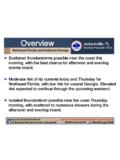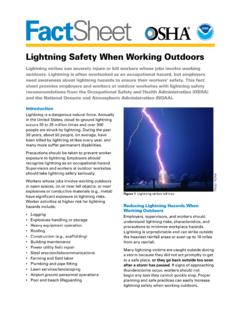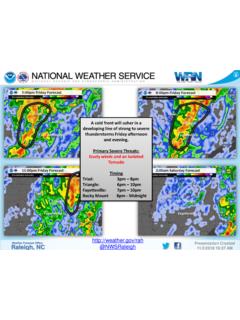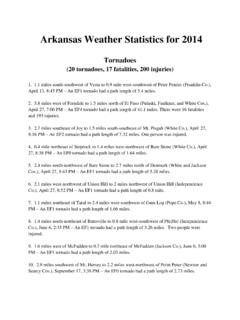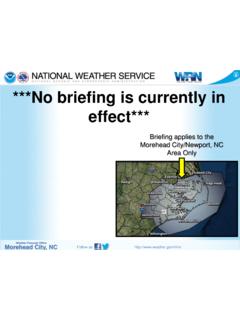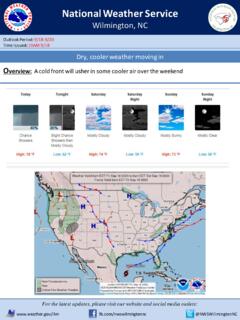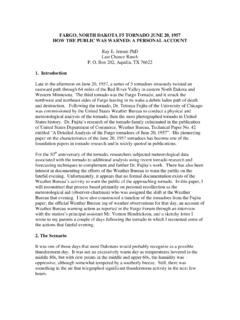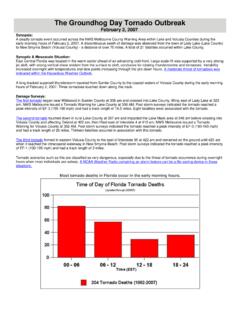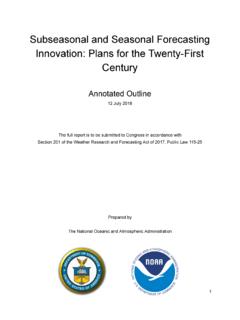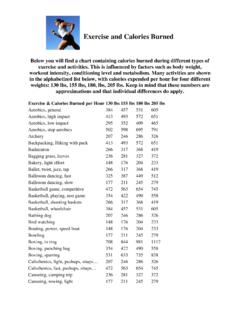Transcription of Types of Lightning Lightning Facts - National Weather …
1 Severe Weather Safety Guide LightningLightningLightningLightning A reference guide from your National Weather Service Paducah, Kentucky Types of Lightning Intra-Cloud: The most common type of Lightning . It happens completely inside the cloud, jumping between different charge regions in the cloud. Intra-cloud Lightning is sometimes called sheet Lightning because it lights up the sky with a 'sheet' of light. Cloud to Cloud: Lightning that occurs between two or more separate clouds. Cloud to Ground: Lightning that occurs between the cloud and the ground. Cloud to Air: Lightning that occurs when the air around a positively charged cloud top reaches out to the negatively charged air around it.
2 Bolt from the blue: A positive Lightning bolt which originates within the updraft of the storm, typically 2/3rds of the way up, travels horizontally for many miles, then strikes the ground. Anvil Lightning : A positive Lightning bolt which develops in the anvil, or top of the thunderstorm cloud, and travels generally straight down to strike the ground. Heat Lightning : Lightning from a thunderstorm that is too far away to be heard. Lightning Facts : - Lightning causes an average of 80 deaths and 300 injuries each year. - The energy from one Lightning flash could light a 100 watt light bulb for more than 3 months. - Only about 10% of people that are struck are actually killed.
3 90% survive, but nearly 25% of these survivors suffer long term psychological or physiological trauma. - 92% of Lightning injuries and deaths occur between May and September. - 45% of the deaths and 80% of injuries occurred in these months between 10am and 7pm. - Rubber-soled shoes & rubber tires provide NO protection from Lightning . - Lightning can strike more than 10 miles away from any rainfall. More than 50% of Lightning deaths occur AFTER the storm has passed. Thunder: The air near a Lightning strike is heated to 50,000 degrees Fahrenheit, which is hotter than the surface of the sun. Rapid heating and cooling of air near the Lightning channel causes a shock wave that results in thunder.
4 Thunder from a nearby Lightning strike will have a very sharp crack or loud bang. Thunder from a distant strike will have a continuous rumble. FLASH BANG METHOD: Count the number of seconds between the Lightning flash and the sound of the thunder, and divide that number by five. That number is the number of miles the storm is away from you. If you can hear thunder, the storm is close enough that Lightning could strike your location at any moment! If you hear it clear it! Do not resume outdoor activities until 30 minutes after the last clap of thunder. How does Lightning form? When a thunderstorm develops, electrical charges within the cloud separate, and an electric field is produced between the top of the cloud and the base.
5 Below the negatively charged storm base, positive charges begin to gather on the ground. A cloud to ground Lightning strike begins as an invisible channel of electrically charged air moving from the cloud toward the ground. When one channel nears an object on the ground, a powerful surge of electricity from the ground moves upward to the clouds and produces the visible Lightning strike. This type of Lightning is called negative Lightning because negative charges are moving from the cloud to the ground. Sometimes, Lightning will come from the upper parts or near the top of the storm, where the positively charged particles are located. These Lightning bolts are called positive Lightning because positive charges are moving from the cloud to the ground.
6 Although not as common as negative Lightning , the positive Lightning is much more dangerous because its charge can be ten times greater than a negative Lightning strike. Plus, many positive Lightning strikes occur near the edge of the cloud, sometimes as far as 10 miles away from any rainfall! Lightning Safety Rules The best shelter from Lightning is inside a large enclosed structure, such as your home or school. No place outside is safe during a thunderstorm. Once inside, stay away from any windows and doorways, electrical appliances, lighting, electric sockets, and plumbing, such as toilets and showers. If you can t get to a house, a vehicle with a solid metal roof and metal sides (such as a bus) is a reasonable second choice.
7 Avoid contact with the windows. Close the windows and lean away from the door. Don t touch anything metal, such as the steering wheel, ignition, gear shifter or radio. Stay away from: -Tall isolated objects (trees, flag poles, light poles, field goal posts, telephone poles) -Wide-open areas (sports fields, farm fields, hiking trails) -Water related activities (boating, fishing, lying on the beach, swimming) -Open vehicles (farm tractors, riding lawn mowers, golf carts) -Unprotected buildings (picnic pavilions, rain shelters, bus stops, car ports, open garages, covered patios, dugouts, porches, sheds) -Metal (fences, bleachers, tools, golf clubs) -Using the telephone and showers (using a corded phone is the leading cause of indoor Lightning injuries)
8 - Cordless phones and cell phones are considered safe. Lightning Warning Signs Sometimes Lightning will give you a few seconds of warning before it strikes: Your hair will stand on end Your skin will tingle Light metal objects vibrate or buzz Metallic taste in your mouth Palms get sweaty Crackling or kee kee sound Smell of ozone (swimming pool smell) At night, a blue glow may show from an object People have been killed or seriously injured by Lightning while.
9 Boating, Swimming, Golfing, Bike riding , Standing under a tree, riding a lawnmower, Talking on the telephone, Loading a truck, riding a horse, Playing soccer, Fishing in a boat, Mountain climbing, just to name a few! Lightning may hit the same place or person several times. Ray Sullivan, a retired National Park Ranger was hit 7 times! He has been knocked down, picked up and thrown into the air, lost his shoes and a toenail, and can t hear as well, but he s alive! REMEMBER: There is no safe place outside during a thunderstorm. The key to reducing your chances of being struck, is to be proactive and already be situated in a safe location BEFORE Lightning threatens.
10
